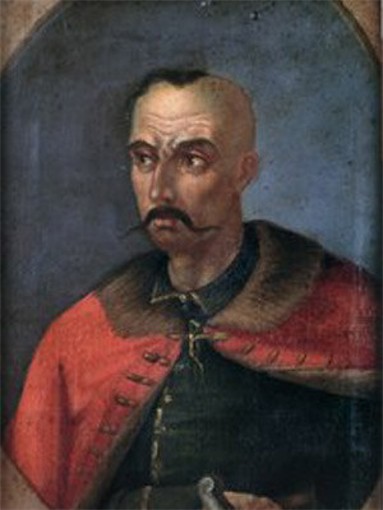Palii, Semen
Palii, Semen [Палій, Семен; Palij] (actual surname: Hurko), b early 1640s in Borzna, Chernihiv region, d between 24 January and 13 May 1710 in Kyiv. (Portrait: Semen Palii.) Cossack leader. He studied at the Kyivan Mohyla College and became a registered Cossack of Nizhyn regiment. In the 1670s he joined the Zaporozhian Host and distinguished himself as a soldier and administrator. He served as a volunteer colonel in King Jan III Sobieski's army and, according to some sources, took part in the rout of the Turks and Crimean Tatars at Vienna in 1683. In 1685 the Polish Sejm adopted a constitution confirming the rights and freedoms given to the Cossacks by the Polish kings, and Cossack regiments were established in Fastiv (see Fastiv regiment) and Bohuslav and revived in Korsun (see Korsun regiment) and Bratslav (see Bratslav regiment). In 1684–5 Palii lived with his regiment around Fastiv and soon became the de facto ruler of the Bila Tserkva region. In the 1680s and 1690s Palii led successful campaigns against the Turks and Tatars as an ally of Poland and of Hetman Ivan Mazepa. He concentrated his efforts, however, on recolonizing the territories of Right-Bank Ukraine that had been devastated by the Tatars, liberating them from Polish rule, and uniting them with the Hetman state in Left-Bank Ukraine. In 1689 his forces attacked Nemyriv, where he was captured by the Poles and imprisoned. He was freed after the intervention of Jan Sobieski in 1690.
Palii's relations with Poland deteriorated after the Sejm ordered the liquidation of all Right-Bank Cossack regiments by force in 1699. In 1702 he and other Right-Bank Cossack leaders under Hetman Samiilo Samus led an uprising against Polish rule that quickly spread throughout Kyiv voivodeship, Bratslav voivodeship, and Podilia voivodeship and even affected Galicia. The rebels did not manage, however, to gain the support of the Left-Bank Hetman state and Russia, which did not want to annex the Right Bank. In 1703 the rebellion was crushed by a large Polish army, and its participants were brutally punished (10,000 were executed). Palii then turned for support to pro-Swedish Polish magnates. Hetman Ivan Mazepa, who opposed Palii's radical social policies and feared his popularity among the Zaporozhian Cossacks, sent troops into Right-Bank Ukraine to help the Poles suppress the uprising and had Palii arrested. Palii was deported to Moscow and exiled in 1705 to Siberia. After Mazepa broke with Moscow, Palii was allowed to return to Ukraine. After the Battle of Poltava he resumed command of Bila Tserkva regiment. He was buried at the Mezhyhiria Transfiguration Monastery near Kyiv.
BIBLIOGRAPHY
Andrusiak, M. ‘Do istoriï pravobichnykh kozakiv v 1689–1690 rr.,’ ZNTSh, 100 (1930)
———, Mazepa i Pravoberezhzha [sic] (Lviv 1938)
Diadychenko, V. Semen Palii (Saratov 1942)
Perdenia, J. Stanowisko Rzeczypospolitej szlacheckiej wobec sprawy Ukrainy na przełomie XVII–XVIII w. (Wrocław 1963)
Serhiienko, H. Vyzvol’nyi rukh na Pravoberezhnii Ukraïni v kintsi XVII i na pochatku XVIII st. (Kyiv 1963)
Oleksander Ohloblyn
[This article originally appeared in the Encyclopedia of Ukraine, vol. 3 (1993).]


.jpg)